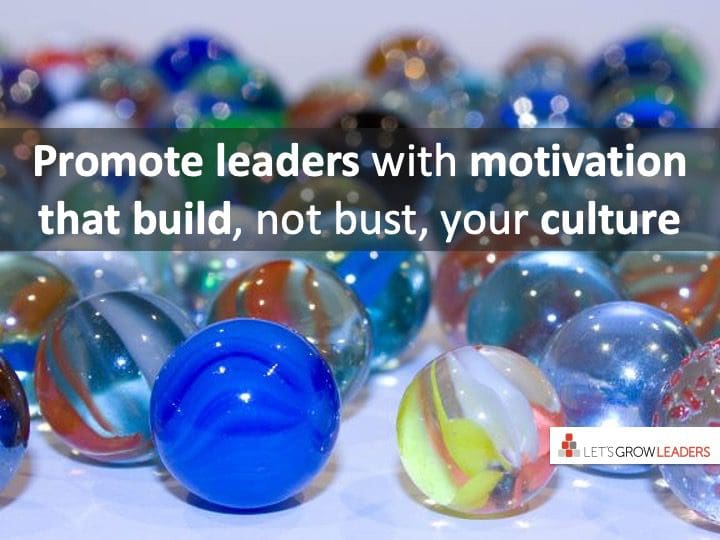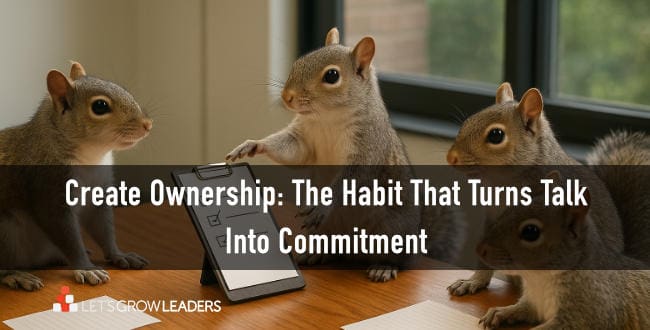Promote leaders who show their commitment to relationships and results.
One of the most important leadership decisions you’ll ever make is the choice to promote someone into a leadership role. Who you promote into leadership sends a powerful message of what matters most in your organization. Promote leaders aligned with your culture and you’ll build momentum. Get this wrong, and you undo all the good you’ve done.
It’s sobering to consider: all of your values, everything your company stands for, the major day-to-day experience of the organization – all of it …
… is experienced by an employee through their immediate supervisor.
And, the data continue to suggest that for the vast majority of employees, that experience is not a good one.
Promote Leaders with Culture-Building Motivation
The first place to focus your attention is motivation: why does the person you’re considering promoting want to lead?
There are five common reasons people seek out promotions to management and leadership roles. We call these the 5 Ps of Leadership Motivation. Here are the first three:
- Power—the perception of control
- Paycheck—the financial incentives
- Pride—the prestige they feel that comes with a title
There is nothing inherently wrong with these motivations. They’re human nature.
The challenge is that people who want to lead primarily for these three reasons won’t succeed.
The desires for power, more money, or prestige are selfish motivations. They’re about the person, not their team or the work. A leader who shows up every day to fulfill those motivations won’t have influence with their people.
People who take leadership roles for these reasons often experience frustration. The power is an illusion, the increased pay rarely feels worth the additional responsibilities, and the prestige of a title isn’t a lasting source of self-esteem. They can’t provide the hope their people need.
These managers either decide it’s not for them, or they go after the next promotion, thinking “this will be the one.”
The final two motivations are different:
- Purpose—the reason for the work, the results the team exists to achieve
- People—supporting, developing, and bringing people together as a team
Leaders who focus on Purpose or People naturally have more influence. They connect to their team and help everyone achieve more than they could individually. People are better off for having worked with these leaders.
Promote Leaders who Show Ability
After motivation, the next step is to make sure they have the core competencies to succeed in the role. Look for people with the ability to:
- Do their core work with credibility and competence
- Influence others without relying on formal authority
- Use power judiciously
- Have a difficult conversation when needed
There are many more leadership and management skills to master, but these fundamental abilities allow a newly promoted person to learn while they lead.
Finding Candidates with the Motivation and Ability to Lead Well
As with any position, the best candidates are those who already demonstrate core competencies. You can look for high potential leaders in action learning projects, interdepartmental teams, committees, ad hoc projects, interim-assignments when a supervisor is absent, and employee-sponsored initiatives.
These opportunities can reveal leadership motivations while giving growing leaders a chance to practice influence without a formal title. You can also observe how they use the limited authority that these roles afford. Can they be trusted with power? Do they focus on the purpose and build relationships?
Leadership development programs also provide a great chance to see who is serious about the opportunity to lead. If you’re using a 9-box succession planning strategy, you can include these motivations and abilities in your calibration discussions.
Finally, an excellent litmus test is: “Would I want my child working for this person?”
Your Turn
When you promote leaders you either build or bust your culture. We’d love to hear from you: How do you ensure you develop and promote leaders who build a positive culture?
See Also: 9 Creative Ways to Develop your Managers







0 Comments